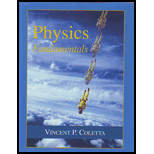
(a)
The escape velocity for the moon.
(a)
Answer to Problem 63P
The escape velocity of Moon is 2.38 km/s.
Explanation of Solution
Formula Used:
The escape velocity of a particle to escape the gravitational field of the Moon is given as
Where, G is the gravitational constant of Moon is
Calculation:
Substitute the values:
Conclusion:
The escape velocity of Moon is 2.38 km/s.
(b)
The velocity of the particle in the earth’s environment.
(b)
Answer to Problem 63P
The velocity withwhich particle will enter the Earth’s surface is
Explanation of Solution
Given Data:
The energy conservation is given as
Particle at moon starts with a
Formula Used:
Using equation 1, write
Putting the initial velocity equal to the escape velocity from moon, we can write:
Solving for final velocity
Calculation:
Conclusion:
The velocity withwhich particle will enter the Earth’s surface is
(c)
The ratio of final to initial kinetic energy of the particle.
(c)
Answer to Problem 63P
The ratio of final to initial kinetic energy of the particle is 24.86.
Explanation of Solution
Given data:
Particle at moon starts with a
Formula Used:
When particle is at the surface of moon, then the potential energy of particle and Earth is neglected as it is far from the Earth. The velocity with which particle will enter the Earth’s surface is
Ratio is given as below:
Calculation:
Putting the values of radius and mass of earth and moon, we get,
Conclusion:
The ratio of final to initial kinetic energy of the particle is
Want to see more full solutions like this?
Chapter 7 Solutions
Physics Fundamentals
- Check Your Understanding Why not use the simpler expression U=mg(y2y1) ? How significant would the error be? (Recall the previous result, in Example 13.4, that the value g at 400 km above the Earth is 8.67m/s2 .)arrow_forwardFind the escape speed of a projectile from the surface of Mars.arrow_forwardFind the escape speed of a projectile from the surface of Jupiter.arrow_forward
- Check Your Understanding If we send a probe out of the solar system starting form Earth’s surface, do we only have to escape the Sun?arrow_forwardRank the following quantities of energy from largest to the smallest. State if any are equal. (a) the absolute value of the average potential energy of the SunEarth system (b) the average kinetic energy of the Earth in its orbital motion relative to the Sun (c) the absolute value of the total energy of the SunEarth systemarrow_forwardAn average-sized asteroid located 5.0107km from Earth with mass 2.01013kg is detected headed directly toward Earth with speed of 2.0km/s . What will its speed be just before it hits our atmosphere? (You may ignore the size of the asteroid.)arrow_forward
- Check Your Understanding You probably recall that, neglecting air resistance, if you throw a projectile straight up, the time ii takes to reach its maximum height equals the time it takes to fall from the maximum height back to the starting height. Suppose you cannot neglect air resistance, as in Example 8.8. Is the time the projectile takes to go up (a) greater than, (b) less than, or (c) equal to the time It takes to come back down? Explain.arrow_forwardWhy can a squirrel jump from a tree branch to the ground and nm away undamaged, while a human could break a bone in such a fall?arrow_forward(a) Determine the kinetic energy per unit mass that a missile must have after being fired from the surface of the earth if it is to reach an infinite distance from the earth. (b) What is the initial velocity of the missile (called the escape velocity)? Give your answers in SI units and show that the answer to part b is independent of the firing angle.arrow_forward
- Calculate the valu of the time of flight of K-39 (K39) ion that has a kinetic energy of 12.2 x 10-18 J when the distance of the flight tube is 80 cm longarrow_forward(a) Evaluate the gravitational potential energy between two 5.00-kg spherical steel balls separated by a center-to-center distance of 15.0 cm. (b) Assuming that they are both initially at rest relative to each other in deep space, use conservation of energy to find how fast will they be traveling upon impact. Each sphere has a radius of 5.10 cm.arrow_forwardConsider an object of mass m in a circular orbit of radius r and angular velocity w about a larger object of mass M and radius R, where M >> m. (a) What is the the potential energy of the mass-m in its circular orbit, assuming that r > R? (b) In 1. Vectors and kinematics, we showed that the acceleration in the radial direction of an object in a circular orbital of radius r and angular velocity w is w²r. Use this result, and the result that the velocity of such an object is wr to calculate the mass-m object's kinetic energy in terms of G, M, m, and r. 3.11. PROBLEMS 117 (c) Calculate the corresponding velocity of the mass m object in terms of G, M, m, and r. (d) What is the total mechanical energy of the mass m-mass M system? (e) How do the potential, kinetic, and total compare in this gravitational bound state? (f) Now, suppose that the mass density of the mass M object at radius s is p(s). What is the total mass within radius r? (g) It turns out that for an object orbiting at radius…arrow_forward
 University Physics Volume 1PhysicsISBN:9781938168277Author:William Moebs, Samuel J. Ling, Jeff SannyPublisher:OpenStax - Rice University
University Physics Volume 1PhysicsISBN:9781938168277Author:William Moebs, Samuel J. Ling, Jeff SannyPublisher:OpenStax - Rice University Classical Dynamics of Particles and SystemsPhysicsISBN:9780534408961Author:Stephen T. Thornton, Jerry B. MarionPublisher:Cengage Learning
Classical Dynamics of Particles and SystemsPhysicsISBN:9780534408961Author:Stephen T. Thornton, Jerry B. MarionPublisher:Cengage Learning Principles of Physics: A Calculus-Based TextPhysicsISBN:9781133104261Author:Raymond A. Serway, John W. JewettPublisher:Cengage Learning
Principles of Physics: A Calculus-Based TextPhysicsISBN:9781133104261Author:Raymond A. Serway, John W. JewettPublisher:Cengage Learning College PhysicsPhysicsISBN:9781285737027Author:Raymond A. Serway, Chris VuillePublisher:Cengage Learning
College PhysicsPhysicsISBN:9781285737027Author:Raymond A. Serway, Chris VuillePublisher:Cengage Learning



